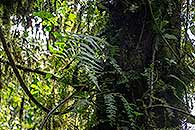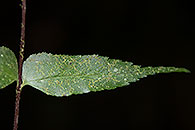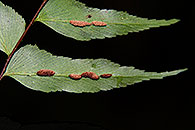Asplenium ramicola Eb. Fisher & Lobin
Synonyms |
|
|---|---|
Common name |
|
Description |
Rhizome creeping, up to 11.5 cm long, densely scaly; rhizome scales lanceolate in outline with long filiform apex, 1.8–2.51 × 0.55–0.62 mm at base, × 0.37 mm at middle part, and × 0.17–0.2 mm at apex, scales dark brown, cells with prominent dark walls, 0.07–0.08 × 0.03–0.04 µm. Fronds monomorphic, spaced, pendent. Stipes 17.5–22 cm, maroon to dark brown, canaliculated, glabrous. Lamina 1-pinnate, elliptic in outline, 22–41.5 × (13.5)16–22.8 cm, upper surface green, lower surface greyish-green; pinnae 9–13 pairs, subopposite, basic pinnae as big as or slightly smaller than the others, tapering; terminal pinna lanceolate to ovate with base confluent with highest lateral pinnae, irregularly pinnatifid, glabrous, 4.5–5(7.5) × 3–4 cm near base, lateral pinnae 7.5–11.4 × 1.3–2 cm, lanceolate, toothed on both margins, asymmetric, basiscopic side at the base not serrate, long-acuminate, acumen up to 2.5 cm long; veins dichotomously branched; rhachis brown, with few hair-like scales. Sori in two rows parallel to the midrib, so when mature, they seem to be confluent, broad elliptic, 0.5–0.7 × 0.25 mm, indusia not seen. Spores with reticulate perispore. |
Notes | Can be distinguished from Asplenium friesiorum by the lower number of lateral pinnae (7–10(12) vs. 19–24 in A. friesiorum), the terminal section lanceolate to ovate, irregularly pinnatifid, with bases confluent with lateral pinnae (vs. linear-lanceolate, elongate, lobed to slightly pinnatifid, not confluent with lateral pinnae in A. friesiorum), and in size of scale cells being considerably smaller (0.07–0.08 µm vs. 0.12–0.14 µm in A. friesiorum); lastly, the spores are different in size and shape. From Asplenium biafranum the new species differs by the smaller scales (0.55–0.62 mm vs. 1–2 mm in A. biafranum), the number of cells in a transversal row at lower third of the scale does not exceed 17–20 in A. ramicola (generally 29–33 in A. biafranum and 37–41 in A. friesiorum), also the spores are different. |
Derivation | ramicola: refers to the place where the species has first been discovered, i.e, small branches in the canopy from a Pentadesma reyndersii (Clusiaceae) tree. |
Habitat | Canopy epiphyte. Nyungwe NP at Gisakura, descent to waterfalls, elev. of 1953 m on a ca 30 m high fallen tree (Pentadesma reyndersii). Near Karamba at km 100, road from Huye to Rusizi, growing on a mossy tree trunk at c. 10 m from the ground. |
Distribution worldwide | See African distribution. |
Distribution in Africa |
|
Growth form |
Epiphytic. |
Literature |
|




